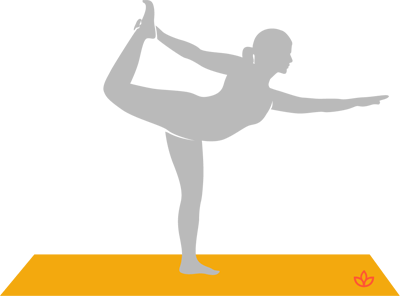Dancer’s pose, also called natarajasana in Sanskrit, has been one of my most favorite yoga postures for as long as I can remember. Maybe it’s because I grew up studying dance. All I know is I love it, and my affection for the elegant pose soared to even greater heights when an Indian sculptor in Mamallapuram, India gave me one of his small pieces. It just happened to be a replica of the dancing Shiva, also known as Nataraja. While my dancing Shiva wasn’t in dancer’s pose as we know it, she certainly came close. (Learn more in An Introduction to Lord Shiva: The Destroyer.)

I carried that sculpture with me for nearly 15 years until it broke somewhere along the way. Today, I practice natarajasana whenever I want to remember a part of myself I might have forgotten—that 20-year-old innocent, who fearlessly wandered through India and beyond.
Funny how yoga poses can do that for us. Just like music, yoga asana have the ability to bring us back to distant times and places. Today, I’m a little more practical. I’ve naturally lost some of my wanderlust. And my safety in the world, as well as in my yoga practice has become more important. For this reason, I’d like to touch upon the four common mistakes of dancer’s pose and how to fix them. Because, like my statue, we can’t dance when we’re broken.
1. You Don’t Warm Yourself Up
Think about it. In essence, dancer’s pose is a peak pose. It’s not for beginners. And it’s not for the advanced yogi, who hasn’t properly warmed up properly. Natarajasana stretches and strengthens so many parts of the body (and mind). Your shoulders, chest, legs, mental focus, and equilibrium are all challenged in this asana. As such, you need to warm up those parts of the body (and mind) before leaping into the dance, so to speak.
I would do so, first and foremost, with some sun salutations. They’re such a great way to warm up the entire body. Four or five sun salutations should be sufficient. But, use your own good judgment and do as many as you intuitively think you need. And when you’re at the peak of mountain pose with the arms stretched above, go ahead and bend back a bit. Dancer’s pose is a backbend, too, and you don’t want to pull any muscles on that front!
You might also want to try a simple balancing posture, like tree pose. Do tree pose on both sides, breathing and holding the posture for several breaths. Last but not least, open your shoulders by clasping the hands behind your back. You can work on your backbend here as well. Holds this pose until you feel your shoulders and chest have had a good stretch.
2. You Hyperextend Your Standing Knee
This applies to many of us—especially dancers, who were praised for hyperextending their bodies. In yoga, we don’t hyperextend. Rather, we do the opposite. We microbend joints, such as the standing knee in dancer’s pose, in order to protect it.
Yoga is all about keeping the body healthy over the long-term, without injury. Keeping that standing knee ever-so-slightly bent by engaging your quadricep muscle will do you a world of good, not only in dancer’s pose, but in whatever standing posture lends itself to hyperextension. (Learn more in 7 Simple Principles to Fix Many, if not Most, Common Asana Mistakes.)
I did this for years. It felt natural to hold the outside of my foot with the thumb facing in. But, that’s not how dancer’s pose is done. When you rotate the thumb out, holding the inside of the foot, you’re getting a deep, shoulder-opening. You’re also opening the chest in a more profound way.
This is the beauty yoga poses. In so many instances, one, sole pose works a myriad of different parts of the body. See if you naturally turn your thumb out or in when you grab your foot. If it’s in, and you’re holding onto the outside, you’ll need to practice with it facing out (and holding the inside of the foot) several times before your muscle memory catches on.
4. Your Hips Aren’t Squared
In dancer’s pose, the hips need to be squared and facing forward. This keeps the knee in line, and prevents making the pose something it’s not. It’s not a hip-opener. Keeping the hips squared is essential for maintaining the overall integrity of the posture.
Try doing it the wrong way, with your hip open and your knee facing out. This is a very different pose. Now, do it the right way. Practicing both the right and wrong way helps you understand experientially how to do the pose—rather than theoretically. Thinking things through in the mind is helpful. But there’ s nothing like experiencing it in the body. You need both. (Learn more in 6 Tips for Better Balance in Your Yoga Asana Practice.)
These four common mistakes, when corrected, will take your dancer’s pose to the next level. It’s easy to get swept away by legs swinging high and backs bending dramatically. But let that ego go, and do the pose the way it’s meant to be done. Over the long run, you’ll prefer dancer’s pose in this more mature fashion.
During These Times of Stress and Uncertainty Your Doshas May Be Unbalanced.
To help you bring attention to your doshas and to identify what your predominant dosha is, we created the following quiz.
Try not to stress over every question, but simply answer based off your intuition. After all, you know yourself better than anyone else.